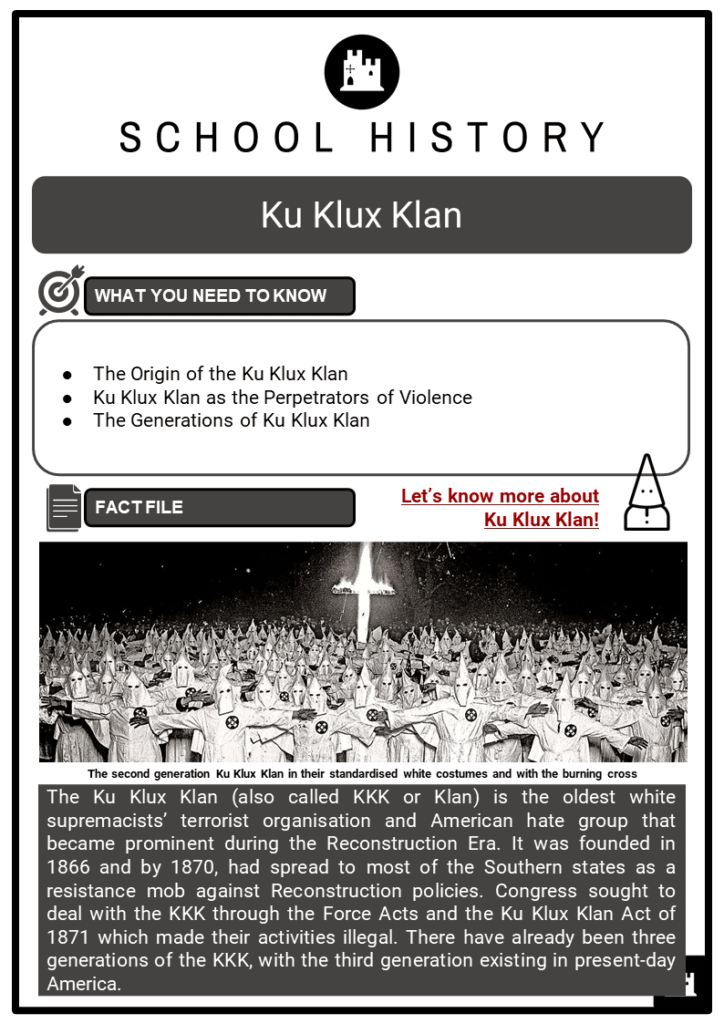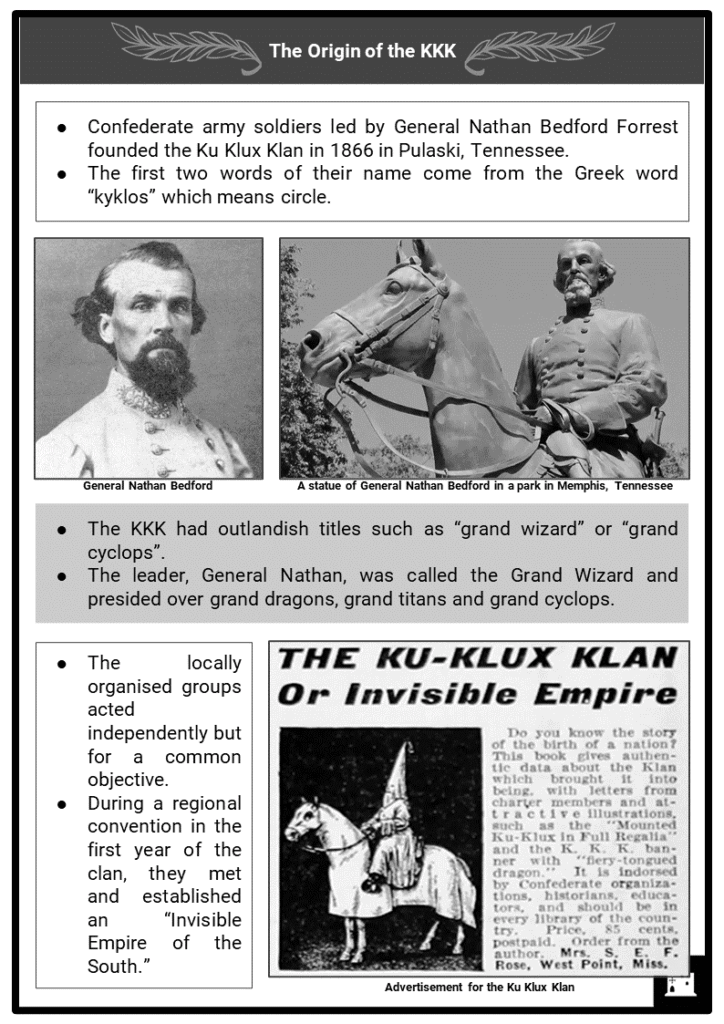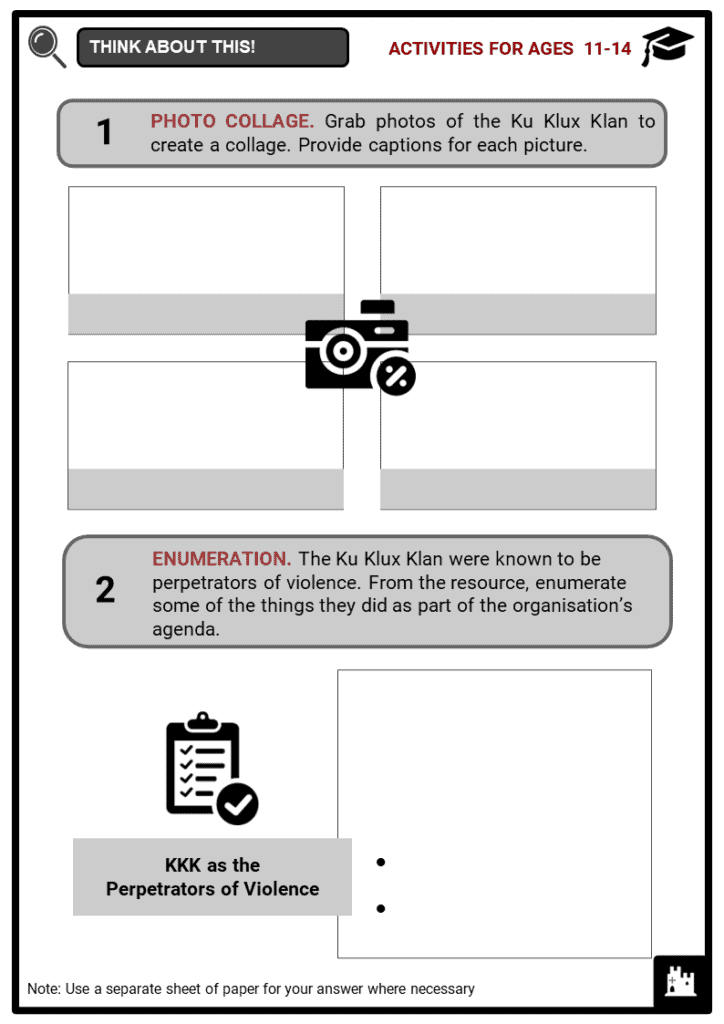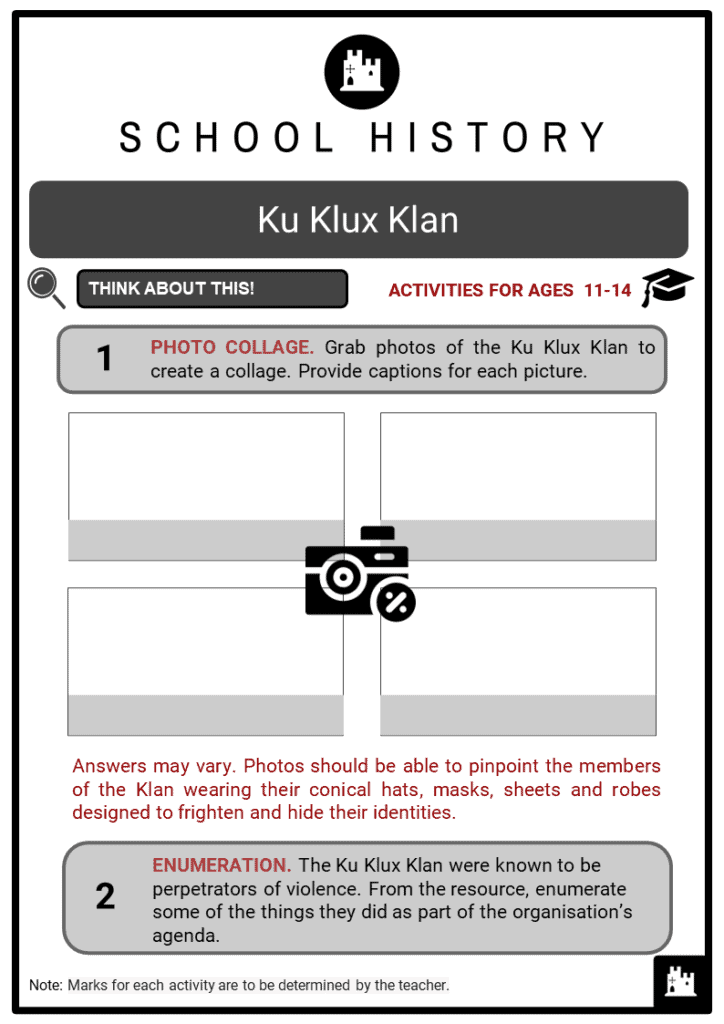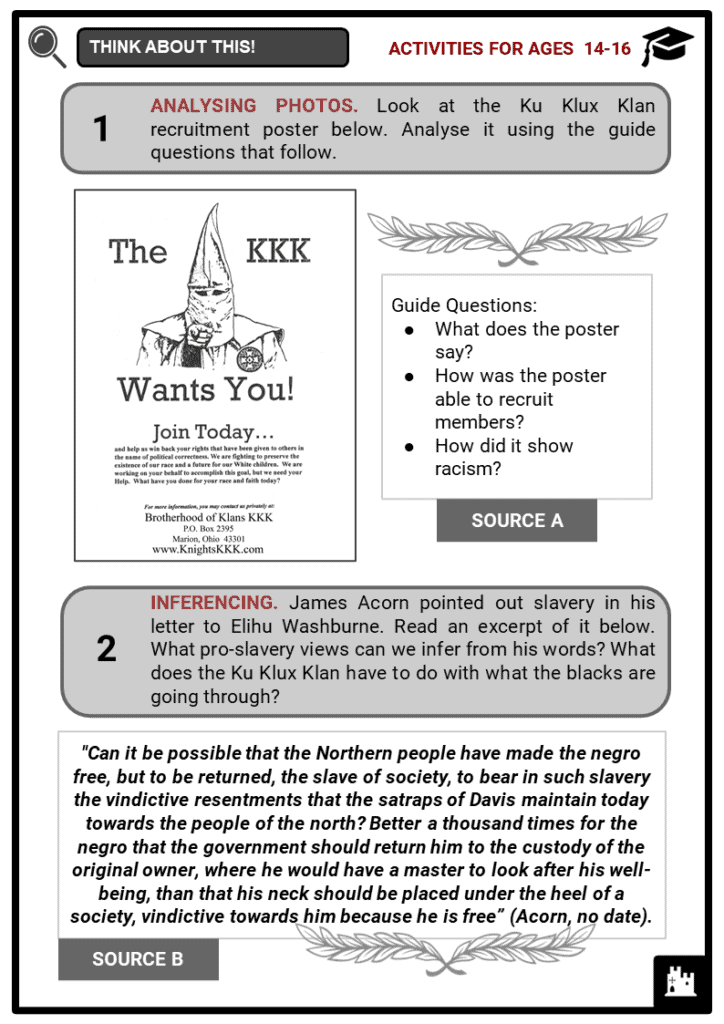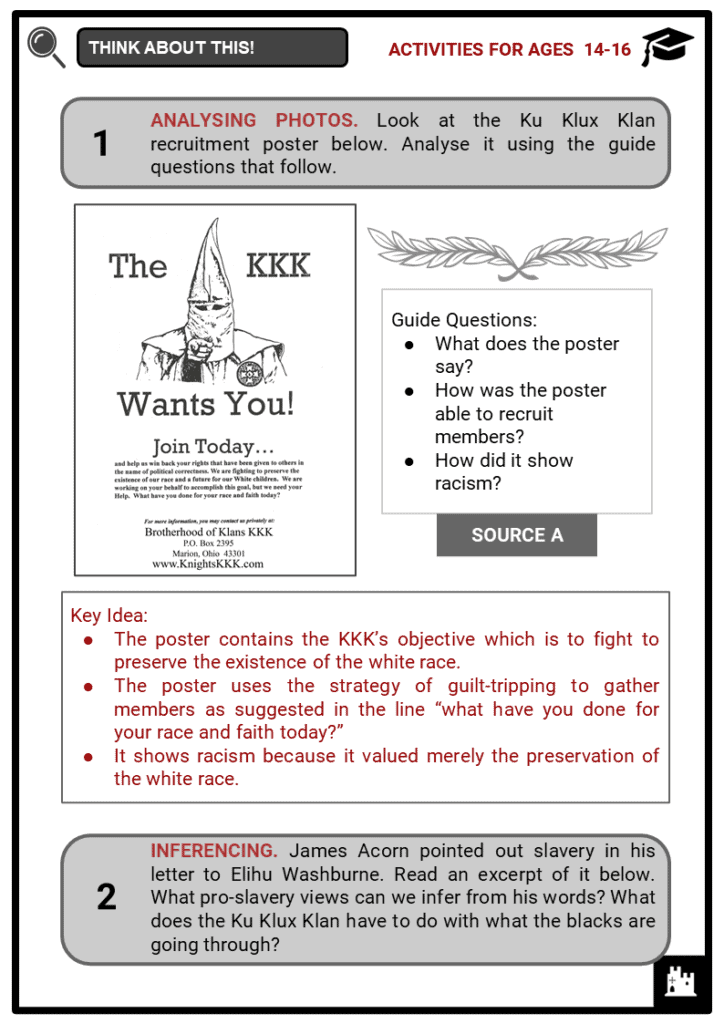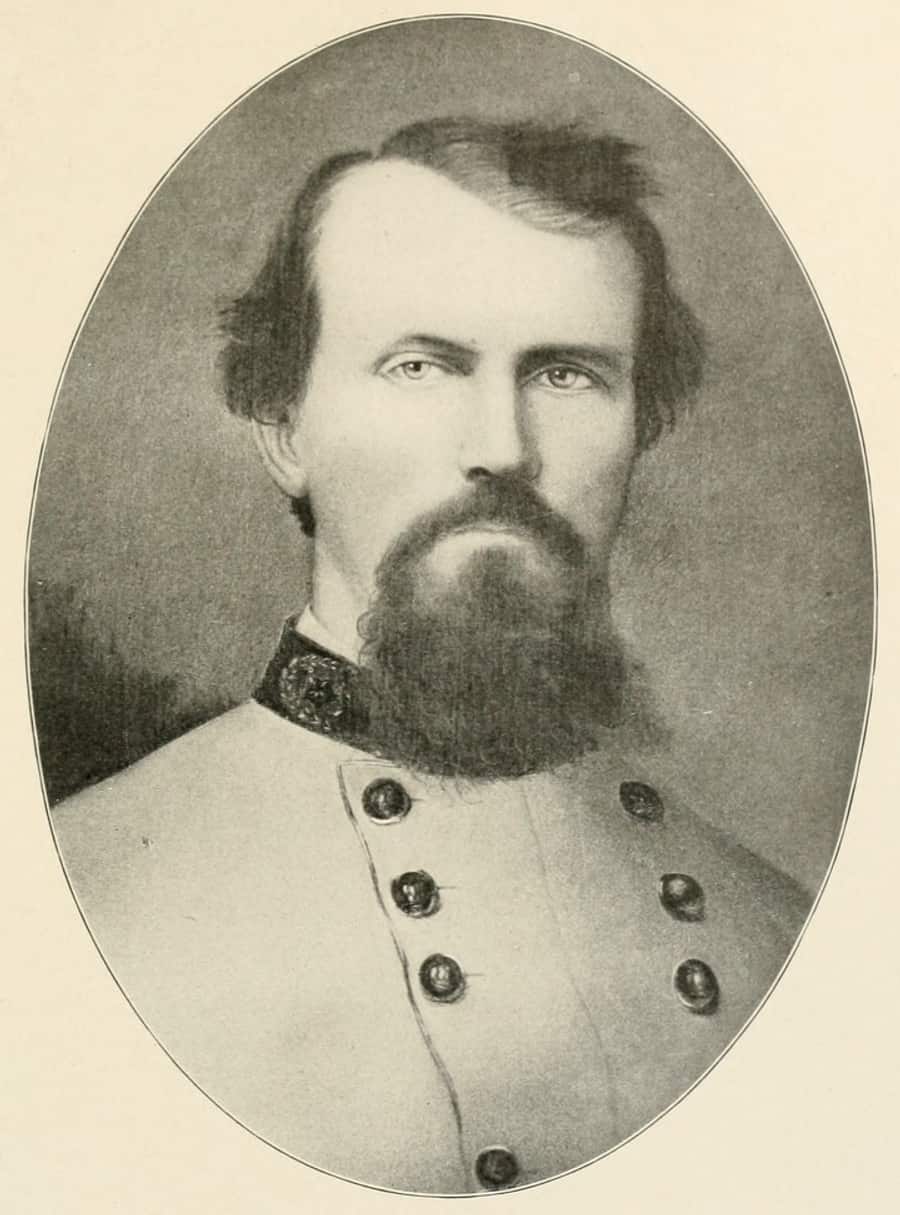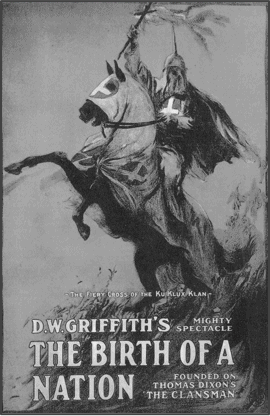Download Ku Klux Klan Worksheets
Do you want to save dozens of hours in time? Get your evenings and weekends back? Be able to teach Ku Klux Klan to your students?
Our worksheet bundle includes a fact file and printable worksheets and student activities. Perfect for both the classroom and homeschooling!
Table of Contents
Add a header to begin generating the table of contents
Summary
- The Origin of the Ku Klux Klan
- Ku Klux Klan as the Perpetrators of Violence
- The Generations of Ku Klux Klan
Key Facts And Information
Let’s know more about Ku Klux Klan!
- The Ku Klux Klan (also called KKK or Klan) is the oldest white supremacists’ terrorist organisation and American hate group that became prominent during the Reconstruction Era. It was founded in 1866 and by 1870, had spread to most of the Southern states as a resistance mob against Reconstruction policies. Congress sought to deal with the KKK through the Force Acts and the Ku Klux Klan Act of 1871 which made their activities illegal. There have already been three generations of the KKK, with the third generation existing in present-day America.
The Origin of the KKK
- Confederate army soldiers led by General Nathan Bedford Forrest founded the Ku Klux Klan in 1866 in Pulaski, Tennessee.
- The first two words of their name come from the Greek word “kyklos” which means circle.
- The KKK had outlandish titles such as “grand wizard” or “grand cyclops”.
- The leader, General Nathan, was called the Grand Wizard and presided over grand dragons, grand titans and grand cyclops.
- The locally organised groups acted independently but for a common objective.
- During a regional convention in the first year of the clan, they met and established an “Invisible Empire of the South.”
KKK as the Perpetrators of Violence
- The Ku Klux Klan, with all its acts of violence, is in no doubt a terrorist organisation and a threat to civil liberties.
- Since it “functioned as the unofficial paramilitary arm of Southern segregationist governments”, it allowed the KKK members or Klansmen to “kill with impunity” and “eliminate activists by force without alerting federal authorities” (Head 2020).
- Upon the failure of Andrew Jackson’s lenient Reconstruction policies implemented from 1865 to 1866, Congress passed the Reconstruction Acts over a Presidential veto.
- The South got divided into five military districts and were required to ratify the Fourteenth Amendment that granted equal protection of constitutional rights to African-Americans.
- For the first time, African-Americans were able to vote and successfully vied for elective posts in the local government and Congress.
- The Klansmen were in bids to restore white supremacy.
- They dedicated themselves to undercover violence in the South, against black people, and Republican supporters disparaged as scalawags and carpetbaggers.
- The KKK disguised themselves in their costumes, attacking only at night.
- At the time, they claimed to be the ghosts of the Confederate soldiers.
- It is estimated that they undertook approximately 3,500 lynches between 1865 – 1900.
- They were joined in their violent campaigns by the White Camelia and White Brotherhood which were also militia groups.
- During the wake of their violence, seven black legislatures were murdered, and symbols of black emancipation such as schools and churches were attacked.
- Black businesses were also attacked, and white people who conducted business with black people were also attacked by the KKK.
- The KKK thrived in regions where black people were a minority such as South Carolina, where in January 1815, eight black prisoners were killed by Klansmen in the county jail.
- Local law enforcement in the South also sympathised with the KKK and did very little to counter their actions.
- Accused Klansmen were often acquitted due to a supposed lack of sufficient evidence and lack of witnesses to testify against them.
- After 1870, the Enforcement Acts, including the Ku Klux Klan Act of 1871, were enacted.
- The Acts classified the KKK crimes as federal offences.
- Furthermore, the Acts gave the President the power to set aside the writ of habeas corpus and arrest accused individuals without charge.
- The President also had the powers to send federal forces to suppress the KKK in the face of reluctance from state agencies.
- By the end of 1876, the entire South was under Democrats due to the KKK.
- They would kill or threaten Republican officials or politicians.
- During campaigns, Republicans were not able to hold meetings or public rallies to talk to voters out of fear.
- The KKK and other white supremacists voted for literacy tests and other legal mechanisms to suppress the black vote.
- Over time, the Reconstruction period ended, and so did the measures against the KKK.
- However, the KKK attitude was later embodied in the Jim Crow Laws that established racial segregation.
The Generations of KKK
- The first generation of KKK began in the 1860s to the 1870s.
- It flourished in the South during the Reconstruction to overthrow the Republican state governments through voter intimidation and targeted violence against African-American leaders.
- Klansmen from this generation wore “gigantic animal horns, fake beards, coonskin caps, or polka-dotted paper hats… Some Klansmen wore pointed hats suggestive of wizards, dunces, or Pierrots; some wore everyday winter hoods, pillowcases, or flour sacks on their heads” (Kinney 2016).
- These were designed to frighten and hide their identities.
- The second generation emerged in the 1920s to 1940s, inspired by Thomas Dixon “The Clansman” and D.W. Griffins “The Birth of a Nation.”
- They peaked and reached more than 4,000,000 members; however, their numbers dropped by the 1930s during the Great Depression.
- This second generation KKK resisted the Roman Catholics, Jews, foreigners and organised labour using cross burnings and mass parades to intimidate others.
- They also popularised the standardised white hoods and the burning cross known of the KKK today.
- The burning cross idea dates back to medieval Europe when “Scottish clansmen would set fire to hillsides as a statement of military defiance or call to action for soldiers ahead of battle” (Dundon 2017).
- Dixon was inspired by the “fiery cross” and uses it as a scene in his pro-KKK book titled “The Clansman”. The idea of cross burning, however, did not became widespread after the book’s publishing.
- When Dixon sold the film rights to Griffin to create “The Birth of a Nation”, it became a national phenomenon.
- Soon enough, the KKK used the burning cross as their symbol.
- The Ku Klux Klan still exists in present-day America in the form of the third generation KKK which started in 1946.
- This generation focuses on opposing the civil rights movement by using violence like murdering activists.
- Today, the Southern Poverty Law Center (SPLC) estimates about 5,000-8,000 Klansmen worldwide split between factions.
Image sources:
[1.] https://upload.wikimedia.org/wikipedia/commons/6/69/NathanBedfordForrestportrait.jpg
[2.] https://upload.wikimedia.org/wikipedia/commons/6/61/Birth_of_a_Nation_theatrical_poster.jpg

